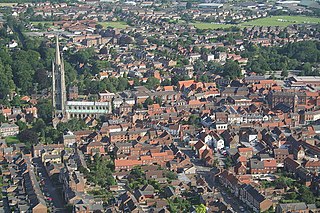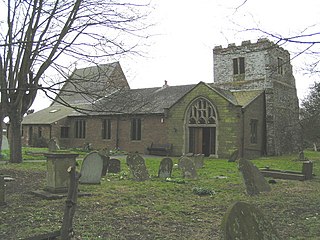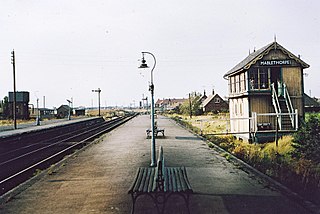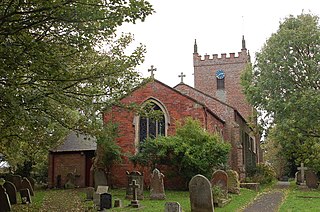
The Great Northern Railway (GNR) was a British railway company incorporated in 1846 with the object of building a line from London to York. It quickly saw that seizing control of territory was key to development, and it acquired, or took leases of, many local railways, whether actually built or not. In so doing, it overextended itself financially.

Louth is a market town and civil parish in the East Lindsey district of Lincolnshire, England. Louth serves as an important town for a large rural area of eastern Lincolnshire. Visitor attractions include St James' Church, Hubbard's Hills, the market, many independent retailers and Lincolnshire's last remaining cattle market.

Alford is a town in the East Lindsey district of Lincolnshire, England, at the foot of the Lincolnshire Wolds, which form an Area of Outstanding Natural Beauty. The population was recorded as 3,459 in the 2011 Census and estimated at 3,830 in 2021. It lies between the towns of Mablethorpe, Louth, Spilsby, and Skegness and acts as a local retail centre.

East Lindsey is a local government district in Lincolnshire, England. Its council is based in Horncastle and the largest town is Skegness. Other towns include Alford, Louth, Mablethorpe, Spilsby and Woodhall Spa. The district also covers a large rural area, including many smaller settlements.

Mablethorpe is a seaside town in the civil parish of Mablethorpe and Sutton, in the East Lindsey district of Lincolnshire, England. In 1961 the civil parish had a population of 3,611. On 1 April 1974 the parish was changed to form "Mablethorpe and Sutton". The population including nearby Sutton-on-Sea was 12,531 at the 2011 census and estimated at 12,633 in 2019.

Willoughby is a village in the district of East Lindsey, Lincolnshire, England. It is situated three miles south from the market town of Alford, and on the edge of the Lincolnshire Wolds, an Area of Outstanding Natural Beauty.

Louth and Horncastle is a constituency in Lincolnshire represented in the House of Commons of the UK Parliament since 2015 by Victoria Atkins, a Conservative.
Mablethorpe and Sutton is a civil parish in East Lindsey, Lincolnshire, England. It is on the North Sea coast and includes Mablethorpe, Trusthorpe, Sutton-on-Sea and Sandilands along with the inland village of Thorpe. According to the 2001 census it had a population of 11,780, increasing to 12,531 at the 2011 Census.

Bilsby is a village and civil parish in the East Lindsey district of Lincolnshire, England. It lies on the main A1111 road between Alford and Sutton-on-Sea, 1 mile (1.6 km) east of Alford. Thurlby and Asserby are hamlets within Bilsby parish. The censuses showed a parish population of 538 in 2001 and 487 in 2011, with an estimate of 489 in 2019.

The coast of Lincolnshire runs for more than 50 miles (80 km) down the North Sea coast of eastern England, from the estuary of the Humber to the marshlands of the Wash, where it meets Norfolk. This stretch of coastline has long been associated with tourism, fishing and trade.
The Lancashire, Derbyshire and East Coast Railway (LD&ECR) was built to connect coalfields in Derbyshire and Nottinghamshire with Warrington and a new port on the Lincolnshire coast. It was a huge undertaking, and the company was unable to raise the money to build its line. With the financial help of the Great Eastern Railway it managed to open between Chesterfield and Lincoln with a branch towards Sheffield from 1896. Despite efforts to promote tourist travel, the passenger business was never buoyant, but collieries were connected to the line, at first and in succeeding years. The Great Eastern Railway, and other main line companies, transported coal to the southern counties, and the company's engines took coal to Immingham in great quantities. The company had a fleet of tank engines.

Willoughby was a railway station on the East Lincolnshire Railway which served the village of Willoughby in Lincolnshire between 1848 and 1970. In 1886, a second larger station replaced the first following the opening of a junction with the Sutton and Willoughby Railway to Sutton-on-Sea and later Mablethorpe. The withdrawal of goods facilities at Willoughby took place in 1966, followed by passenger services in 1970. All lines through the station are now closed.

The East Lincolnshire Railway was a main line railway linking the towns of Boston, Alford, Louth and Grimsby in Lincolnshire, England. It opened in 1848. The ELR Company had leased the line to the Great Northern Railway, and it was the latter which constructed the line and operated it, as its East Lincolnshire Line.
The Kirkstead and Little Steeping Railway, locally known as the New Line, was a railway line in England built to shorten the route between Lincoln and Firsby in Lincolnshire, England.

The Mablethorpe Loop railway was formed in Lincolnshire, England, by two independent railway companies, which built branches from the East Lincolnshire Line.
The Lincolnshire lines of the Great Northern Railway are the railways, past and present, in the English county built or operated by the Great Northern Railway.

Willoughby with Sloothby is a civil parish in the East Lindsey district of Lincolnshire in the East Midlands of England. The parish includes the settlements of Willoughby and Sloothby as well as the hamlets and villages of Bonthorpe, Mawthorpe, Hasthorpe and Habertoft. The parish covers quite a large area of East Lindsey with the towns of Alford, Mablethorpe, Spilsby, Skegness and Burgh le Marsh situated near the parish. The parish's nearest railway station is Skegness. The village of Willoughby was served by a station on the former East Lincolnshire Railway and Mablethorpe Loop Line. However, it closed in 1970 and so did the lines. The station master's house and a section of platform and goods shed survive near the site.

St Peter's Church, Trusthorpe is a parish church in Trusthorpe in Lincolnshire, England. It is one of the oldest churches in Mablethorpe and Sutton parish of East Lindsey along with St Mary's Church in Mablethorpe. The tower was built in 1606, elements of the chancel arch are 14th-century, and the octagonal font is dated as c.1400. It is a Grade II listed church and is an active place of worship and community hub.
















